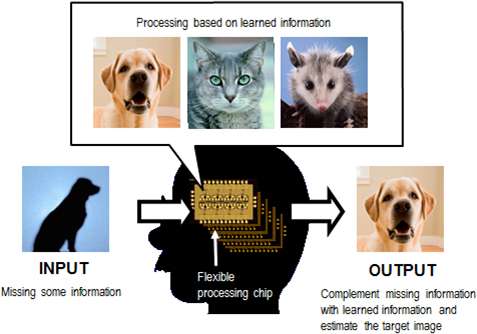Low energy consumption circuit for neural network systems with world's first ferroelectric memristor on a circuit

Panasonic Corporation today announced that it has developed a low energy consumption circuit for neural network systems, by forming the world's first , which can record continuous analog data as resistance, on a CMOS (Complementary Metal-Oxide Semiconductor) circuit. CMOS circuits are widely used as digital circuits. Devices equipped with this technology are able to handle digital signals as analog data in one circuit for the first time. Due to the direct processing of analog data, it is expected that the power consumption of circuits, which have the ability to carry out processing that replicates parts of human thought, such as the ability to make judgments based on broad trends, will decrease drastically to one tenth of the energy consumption of conventional circuits.
The resistance of a ferroelectric memristor can be changed continuously by an applied voltage. As the resistance is maintained without applying a voltage, it acts as a memory device. Therefore, as the device can store data as an intermediate value rather than a binary value (1/0), it is able to store more information than digital memory. Based on this large amount of information stored, through carrying out operations on the efficient analog data, it is possible to reduce the energy consumption as the amount of data to be processed increases. This development will contribute to the realization of a signal processing circuit which mimics the processing of neurons in the brain.
The developed technology has the following features:
- By forming the ferroelectric memristor with a highly oriented lattice on the digital circuit, in which operations on analog data are carried out directly has been made possible. (The power consumption of the analog processing is 10% of a conventional processor when it is applied to pattern recognition.)
- In addition, since analog data stored in a ferroelectric memristor is maintained even when the power supply is cut off, the power can be cut when the ferroelectric memristor is not in use, leading to further reductions in power consumption.
This development is based on the following new technologies.
1.Crystal growth technique for the forming of the ferroelectric memristor on a CMOS circuit through a .
2.Hybrid circuit design to handle digital signals as analog data.
Panasonic holds 35 Japanese patents and 25 overseas patents, including pending applications, for this development.
A part of this technology will be presented at the 2013 Symposia on VLSI Technology and Circuits to be held at the Rihga Royal Hotel Kyoto, Japan on June 11-14.

More on the technology
1. Crystal growth technique for forming the ferroelectric memristor on a CMOS circuit through a seed layer
The atoms in the interlayer insulator film, which covers the surface of a CMOS circuit, have an unordered arrangement. As a result, when a ferroelectric memristor is formed directly on the circuit, the arrangement of the atoms in the ferroelectric film also becomes distorted. In this development, Panasonic has succeeded in forming a ferroelectric memristor with a highly oriented crystal lattice by utilizing a seed layer, which is well ordered and has a close lattice constant to the ferroelectric film.
2. Hybrid circuit design to handle digital signals as analog data
A neural network circuit is a circuit that mimics the signal processing of a neuron in the brain. In this circuit, the information travels between multiple processing units as digital signals known as pulses. Analog processing using the pulses as a current is executed in the processing unit. Panasonic has developed a hybrid circuit design which can seamlessly carry out both digital and analog operations.
Provided by Panasonic Corporation





















